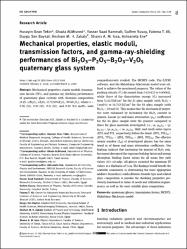Mechanical properties, elastic moduli, transmission factors, and gamma-ray-shielding performances of Bi2O3–P2O5–B2O3–V2O5 quaternary glass system

View/
Date
2022Author
Tekin, H.O.Almisned, G.
Rammah, Y.S.
Susoy, G.
Ali, F.T.
Şen Baykal, Duygu
Zakaly, H.M.H.
Issa, S.A.M.
Ene, A.
Metadata
Show full item recordCitation
Tekin, H., ALMisned, G., Rammah, Y., Susoy, G., Ali, F., Sen Baykal, D., Zakaly, H., Issa, S. & Ene, A. (2022). Mechanical properties, elastic moduli, transmission factors, and gamma-ray-shielding performances of Bi2O3–P2O5–B2O3–V2O5 quaternary glass system. Open Chemistry, 20(1), 314-329. DOI: https://doi.org/10.1515/chem-2022-0145Abstract
Abstract
Mechanical properties, elastic moduli, transmission factors (TFs), and gamma-ray shielding performance of quaternary glass systems with chemical composition (0.25−x)Bi2O3–xB2O3−0.75(50%P2O5−50%V2O5), where x = 0.05 (S1), 0.10 (S2), 0.15 (S3), and 0.20 (S4) mol%, were comprehensively studied. The MCNPX code, Phy-X/PSD software, and the Makishima–Mackenzie model were utilized to achieve the mentioned purposes. The values of the packing density (V t) decreased from 0.634432 to 0.600611, while those of the dissociation energy (G t) increased from 51.6125 kJ/cm3 for the S1 glass sample (with Bi2O3 = 5 mol%) to 56.7525 kJ/cm3 for the S4 glass sample (with Bi2O3 = 20 mol%). This means that the mechanical properties were enhanced by increasing the Bi2O3 content in glasses. Linear (µ) and mass attenuation (µ m) coefficients for the S4 glass sample were the greatest compared to those for glass materials investigated, i.e., (µ, µ m)S1 < (µ, µ m)S2 < (µ, µ m)S3 < (µ, µ m)S4. Half- and tenth-value layers (HVL and TVL, respectively) follow the trend: (HVL, TVL)S1 > (HVL, TVL)S2 > (HVL, TVL)S3 > (HVL, TVL)S4. The effective atomic number (Z eff) of investigated glasses has the same trend as of linear and mass attenuation coefficients. Our findings indicate that increasing the amount of Bi2O3 reinforcement decreased the exposure buildup factor and energy absorption buildup factor values for all mean free path values (0.5–40 mfp). All glasses recorded the minimum TF values at a thickness of 3 cm. The findings would benefit the scientific community in determining the most appropriate additive bismuth(iii) oxide/diboron trioxide type and related glass composition to provide the shielding properties previously mentioned in terms of needs and utilization requirements, as well as the most suitable glass composition.

















